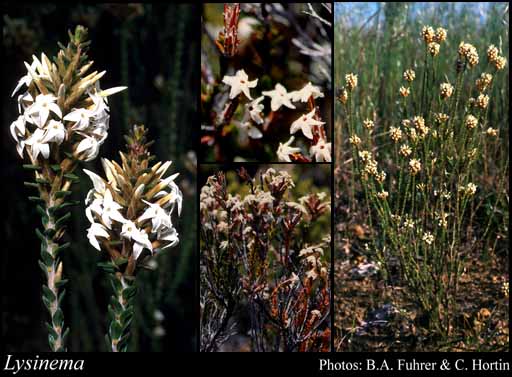- Reference
- Prodr. 552 (1810)
- Name Status
- Current







Scientific Description
Family Epacridaceae.
Habit and leaf form. Shrubs; evergreen; leptocaul, or pachycaul. Helophytic to xerophytic. Leaves minute to small (erect, keeled); alternate; spiral, or four-ranked; ‘herbaceous’, or leathery; imbricate, or not imbricate; petiolate to sessile; non-sheathing (although stem-clasping); simple. Leaf blades entire; flat; palmately veined; cross-venulate, or without cross-venules. Leaves without stipules. Leaf blade margins flat. Stem anatomy. Nodes unilacunar. Secondary thickening developing from a conventional cambial ring.
Reproductive type, pollination. Fertile flowers hermaphrodite. Unisexual flowers absent. Plants hermaphrodite. Entomophilous, or ornithophilous. Pollination mechanism unspecialized.
Inflorescence and flower features. Flowers solitary, or aggregated in ‘inflorescences’; when solitary, axillary (and scattered along the branchlets); in spikes, or in heads. Inflorescences terminal, or axillary; leafy. Flowers subsessile to sessile; bracteate; bracteolate; small to medium-sized; fragrant, or odourless; regular; (4–)5 merous; cyclic; tetracyclic. Free hypanthium absent. Hypogynous disk present; intrastaminal; of separate members (5 scales). Perianth with distinct calyx and corolla; 10; 2 -whorled; isomerous. Calyx 5; 1 -whorled; polysepalous; imbricate; usually exceeded by the corolla; regular; persistent. Corolla 5; 1 -whorled; polypetalous, or gamopetalous; lobed (lobes spreading horizontally); contorted; tubular (tube cylindric, separating in the lower half into distinct petal claws but cohering towards the throat); regular; white, or cream, or red; persistent, or deciduous. Androecium 5. Androecial members free of the perianth, or adnate (slightly, to the corolla tube); all equal; free of one another; 1 -whorled. Androecium exclusively of fertile stamens. Stamens 5; becoming exserted, or remaining included; isomerous with the perianth; oppositisepalous; all alternating with the corolla members. Anthers all alike (linear in outline); attached at or above the middle; becoming inverted during development, their morphological bases ostensibly apical in the mature stamens; non-versatile; dehiscing via longitudinal slits (by a single median slit); finally introrse (inverting during development); unilocular, or bilocular; bisporangiate; unappendaged. Pollen shed in aggregates, or shed as single grains; without viscin strands; in diads, or in triplets, or in tetrads. Gynoecium 5 carpelled. The pistil 5 celled. Gynoecium syncarpous; eu-syncarpous; superior. Ovary plurilocular; 5 locular. Gynoecium stylate. Styles 1; long and slender; from a depression at the top of the ovary; apical; becoming exserted, or not becoming exserted. Stigmas 1; truncate, or clavate, or capitate. Placentation axile. Ovules 3–20 per locule (i.e. ‘numerous’); pendulous; non-arillate; anatropous.
Fruit and seed features. Fruit non-fleshy; dehiscent; a capsule. Capsules loculicidal. Seeds endospermic. Endosperm oily. Seeds wingless. Embryo well differentiated. Cotyledons 2. Embryo straight. Seedling. Germination phanerocotylar.
Physiology, biochemistry. Aluminium accumulation not found. Photosynthetic pathway: C3.
Geography, cytology, number of species. Native of Australia. Endemic to Australia. Australian states and territories: Western Australia. South-West Botanical Province.
Additional characters Prophylls numerous (appressed to the sepals, the bracts and sepals together forming a narrow involucre around each individual flower).
Taxonomic Literature
- Wheeler, Judy; Marchant, Neville; Lewington, Margaret; Graham, Lorraine 2002. Flora of the south west, Bunbury, Augusta, Denmark. Volume 2, dicotyledons. Australian Biological Resources Study.. Canberra..
- Marchant, N. G.; Wheeler, J. R.; Rye, B. L.; Bennett, E. M.; Lander, N. S.; Macfarlane, T. D.; Western Australian Herbarium 1987. Flora of the Perth region. Part one. Western Australian Herbarium.. [Perth]..
- Blackall, William E.; Grieve, Brian J. 1981. How to know Western Australian wildflowers : a key to the flora of the extratropical regions of Western Australia. Part IIIB, (Epacridaceae-Lamiaceae). University of W.A. Press.. [Perth]..